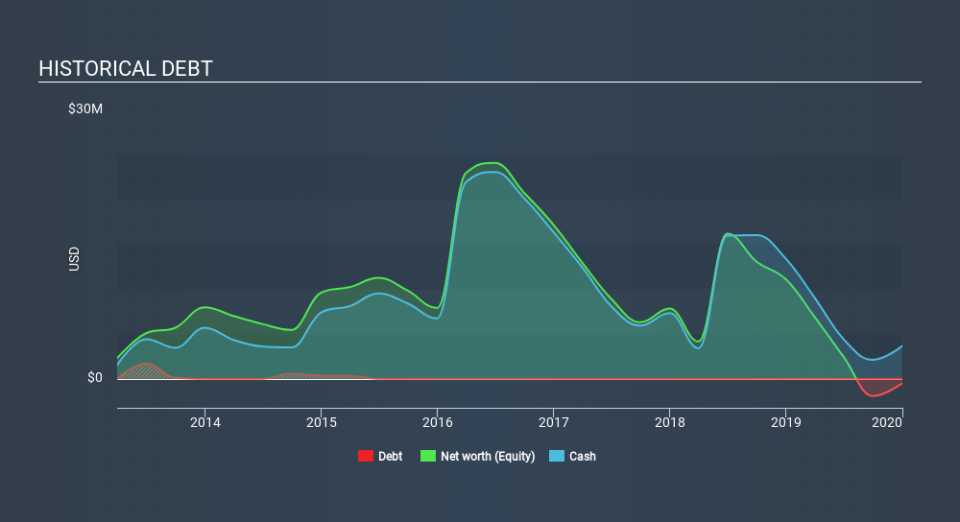Here's Why iBio (NYSEMKT:IBIO) Must Play Its Cards Just Right

We can readily understand why investors are attracted to unprofitable companies. For example, biotech and mining exploration companies often lose money for years before finding success with a new treatment or mineral discovery. But the harsh reality is that very many loss making companies burn through all their cash and go bankrupt.
Given this risk, we thought we'd take a look at whether iBio (NYSEMKT:IBIO) shareholders should be worried about its cash burn. In this report, we will consider the company's annual negative free cash flow, henceforth referring to it as the 'cash burn'. First, we'll determine its cash runway by comparing its cash burn with its cash reserves.
See our latest analysis for iBio
When Might iBio Run Out Of Money?
A cash runway is defined as the length of time it would take a company to run out of money if it kept spending at its current rate of cash burn. In December 2019, iBio had US$3.6m in cash, and was debt-free. Looking at the last year, the company burnt through US$15m. That means it had a cash runway of around 3 months as of December 2019. That's a very short cash runway which indicates an imminent need to douse the cash burn or find more funding. You can see how its cash balance has changed over time in the image below.
How Is iBio's Cash Burn Changing Over Time?
Although iBio had revenue of US$1.7m in the last twelve months, its operating revenue was only US$1.7m in that time period. We don't think that's enough operating revenue for us to understand too much from revenue growth rates, since the company is growing off a low base. So we'll focus on the cash burn, today. Over the last year its cash burn actually increased by 7.3%, which suggests that management are increasing investment in future growth, but not too quickly. However, the company's true cash runway will therefore be shorter than suggested above, if spending continues to increase. In reality, this article only makes a short study of the company's growth data. You can take a look at how iBio is growing revenue over time by checking this visualization of past revenue growth.
Can iBio Raise More Cash Easily?
Since its cash burn is increasing (albeit only slightly), iBio shareholders should still be mindful of the possibility it will require more cash in the future. Companies can raise capital through either debt or equity. Many companies end up issuing new shares to fund future growth. By looking at a company's cash burn relative to its market capitalisation, we gain insight on how much shareholders would be diluted if the company needed to raise enough cash to cover another year's cash burn.
iBio's cash burn of US$15m is about 72% of its US$20m market capitalisation. Given how large that cash burn is, relative to the market value of the entire company, we'd consider it to be a high risk stock, with the real possibility of extreme dilution.
So, Should We Worry About iBio's Cash Burn?
As you can probably tell by now, we're rather concerned about iBio's cash burn. Take, for example, its cash runway, which suggests the company may have difficulty funding itself, in the future. While not as bad as its cash runway, its increasing cash burn is also a concern, and considering everything mentioned above, we're struggling to find much to be optimistic about. Looking at the metrics in this article all together, we consider its cash burn situation to be rather dangerous, and likely to cost shareholders one way or the other. While we always like to monitor cash burn for early stage companies, qualitative factors such as the CEO pay can also shed light on the situation. Click here to see free what the iBio CEO is paid..
Of course, you might find a fantastic investment by looking elsewhere. So take a peek at this free list of interesting companies, and this list of stocks growth stocks (according to analyst forecasts)
If you spot an error that warrants correction, please contact the editor at editorial-team@simplywallst.com. This article by Simply Wall St is general in nature. It does not constitute a recommendation to buy or sell any stock, and does not take account of your objectives, or your financial situation. Simply Wall St has no position in the stocks mentioned.
We aim to bring you long-term focused research analysis driven by fundamental data. Note that our analysis may not factor in the latest price-sensitive company announcements or qualitative material. Thank you for reading.

 Yahoo Movies
Yahoo Movies 

